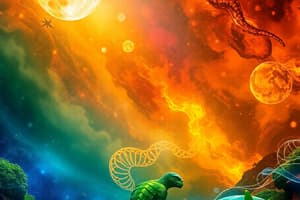Podcast
Questions and Answers
What is the aim of studying cognition across the animal kingdom?
What is the aim of studying cognition across the animal kingdom?
- Identifying specific cognitive abilities in humans
- Studying the physical features of animals
- Understanding how it works, its purpose in nature, and its evolution (correct)
- Exploring the impact of culture on animal cognition
Which field applies evolutionary principles to the working of the human mind?
Which field applies evolutionary principles to the working of the human mind?
- Sociobiology
- Evolutionary psychology (correct)
- Comparative psychology
- Behavioral genetics
What is the emphasis of comparative psychology?
What is the emphasis of comparative psychology?
- Cross-species comparison of animal and human cognition (correct)
- Studying cultural influences on cognition
- Exploring individual differences in cognitive abilities
- Investigating physical features of animals
What do observations and inferences in comparative cognition suggest?
What do observations and inferences in comparative cognition suggest?
What is the relationship between neocortex size and social group size according to Dunbar (2009)?
What is the relationship between neocortex size and social group size according to Dunbar (2009)?
What does scaling brain size against body size reveal?
What does scaling brain size against body size reveal?
What does Barton (2006) suggest scaling one brain part against another should reveal?
What does Barton (2006) suggest scaling one brain part against another should reveal?
How does primate brain size increase in relation to neuron number?
How does primate brain size increase in relation to neuron number?
What does cognition depend on, according to Roth & Dicke (2005)?
What does cognition depend on, according to Roth & Dicke (2005)?
What did Herculano-Houzel (2011) find about the coordination of neuron gain in the cerebral cortex and cerebellum across species?
What did Herculano-Houzel (2011) find about the coordination of neuron gain in the cerebral cortex and cerebellum across species?
What did Barton (2006) emphasize as targets of natural selection in primates?
What did Barton (2006) emphasize as targets of natural selection in primates?
What are the functions mediated by cortico-cerebellar circuits according to Barton (2011)?
What are the functions mediated by cortico-cerebellar circuits according to Barton (2011)?
What can cross-species behavior and structure comparisons inform us about, according to the introduction to studying animal cognition?
What can cross-species behavior and structure comparisons inform us about, according to the introduction to studying animal cognition?
What is perhaps a more informative measure than brain size when studying the 'human brain'?
What is perhaps a more informative measure than brain size when studying the 'human brain'?
What did Deaner et al. (2007) find to best predict cognitive ability across non-human primates?
What did Deaner et al. (2007) find to best predict cognitive ability across non-human primates?
What refers to the total collection of genes within an individual?
What refers to the total collection of genes within an individual?
What are the heritable part of the natural selection equation?
What are the heritable part of the natural selection equation?
What does adaptation refer to?
What does adaptation refer to?
What are the sources of genetic variation?
What are the sources of genetic variation?
What do analogy and homology explain?
What do analogy and homology explain?
What influences the behavior of an animal?
What influences the behavior of an animal?
What is an example of an organism with highly sophisticated navigational skills?
What is an example of an organism with highly sophisticated navigational skills?
What influences navigational abilities in different species?
What influences navigational abilities in different species?
What is used to understand the importance of brain size in different species?
What is used to understand the importance of brain size in different species?
What does the study of natural selection and genetics involve?
What does the study of natural selection and genetics involve?
Flashcards are hidden until you start studying
Study Notes
Understanding Natural Selection and Genetics
- Natural selection acts on variations of phenotype, which includes observable traits such as morphological structures, neural properties, and behaviors.
- Phenotypes are produced by an organism's genotype in combination with environmental and activity-dependent mechanisms.
- Genotype refers to the total collection of genes within an individual, and genes are the heritable part of the natural selection equation.
- Sources of genetic variation include Mendelian variation, chromosome mutation, and gene mutation.
- Adaptation refers to a phenotype arising from genetic variation that increases the probability of an individual producing offspring.
- Analogy and homology are concepts used to explain similarity and resemblance based on function and common ancestry, respectively.
- The behavior of an animal is influenced by internal and external events, experience, genetic makeup, and adaptive value, and it has evolved over time.
- Specialized navigational skills are observed in various species, such as insects, fish, reptiles, birds, and mammals, which use different methods of navigation.
- The Saharan Desert Ant (Cataglyphis fortis) is an example of an organism with highly sophisticated navigational skills, including the ability to measure distance using optic flow and time-lapse integration.
- The relationship between hippocampal and telencephalic volumes influences navigational abilities in different species.
- Brain weight and its proportion to body weight, as well as the concept of allometry and encephalization quotient, are used to understand the importance of brain size in different species.
- The study of natural selection and genetics involves understanding how behaviors and traits have evolved over time, the role of genetic variation, and the influence of environmental factors on phenotype.
Studying That Suits You
Use AI to generate personalized quizzes and flashcards to suit your learning preferences.





